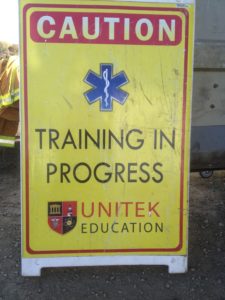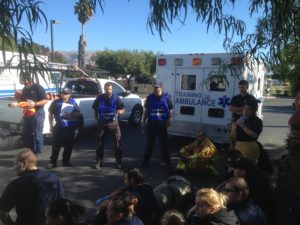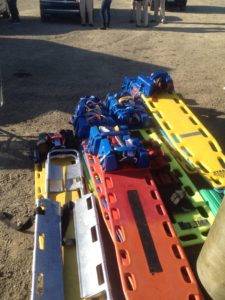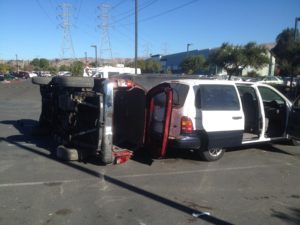This past fall, I took my first EMT course. It was a fast-paced intensive class that took place in Fremont, California and was offered through Unitek College. I loved it. I found that my  background and experience as an instructor of wilderness medicine with Sierra Rescue gave me an upper hand in some of the BLS and patient assessment aspects of the course. Other arenas I was pushed to the max to find space to cram lots of new information.
background and experience as an instructor of wilderness medicine with Sierra Rescue gave me an upper hand in some of the BLS and patient assessment aspects of the course. Other arenas I was pushed to the max to find space to cram lots of new information.
My favorite part of the entire 3-week course was ‘trauma Sundays.’ On these 3 days, we ran mass casualty incident (MCI) scenarios all day long –12 hours worth. The instructors brought on additional proctors and lots of volunteer patients. It was an exhausting marathon of triage, treatment, and transport.
One of the Trauma Sundays featured a crane moving cars for motor vehicle accident (MVA) scenarios, ALS and BLS ambulances arriving on scene for transport, and a surprise arrival of Stanford’s Helicopter. I haven’t spent much time operating with helicopters and it was impressive to see how chaotic the scene can become when the ALS ship arrived.
Throughout the course I kept trying to draw ties to the ‘wilderness’ component which pertains more to my life and the courses that I teach. It was interesting to see firsthand how much front-country medicine relies on two things: diesel and oxygen. If it’s serious you ‘load and go,’ and you almost always give oxygen. These two mainstays of front country medicine are almost never available to us in the wilderness. Transport is hardly ever “rapid” and the best “oxygen supply” we typically carry is in the air we breathe. Given these parameters, when faced with a serious incident in the backcountry. the importance of getting the help you need early in the is paramount, as is the ability to provide treatment and keep your patient as stable as possible.
Overall, it was an awesome course. It gave me some good perspective, provided me with some additional teaching tools, and allowed for my first experiences as a ride-along on the ambulance. It peaked my interest in continuing down a medical path and the possibility of paramedic school. I’m looking forward to teaching my next Wilderness First Responder course this fall.



